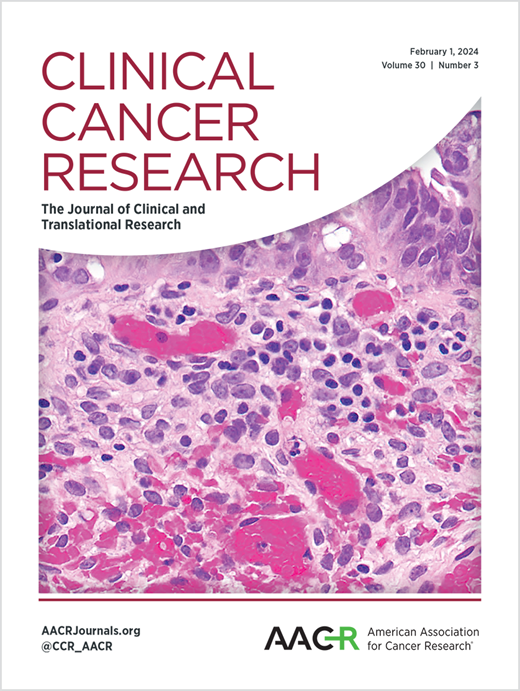B细胞和浆细胞亚群的多标志物评估及其在结直肠癌微环境中的预后作用
IF 10
1区 医学
Q1 ONCOLOGY
引用次数: 0
摘要
目的:虽然细胞毒性 T 淋巴细胞与结直肠癌良好预后之间的关系已得到证实,但 B 淋巴细胞对预后的意义仍不明确。本研究旨在评估结直肠癌中各种 B 细胞和浆细胞亚群的特征和意义。实验设计:我们设计了一种七重免疫组化检测方法,结合基于机器学习的图像分析,来识别各种B细胞和浆细胞群,并将其用于研究912例结直肠肿瘤。我们使用 Kaplan-Meier 估计器和 Cox 回归模型评估了 B 细胞和浆细胞密度的预后意义。此外,我们还设计了一种更适用于临床的三重检测方法,并在 737 名患者组成的单独验证队列中对 B 细胞和浆细胞密度进行了研究。研究结果肿瘤中心浆细胞密度高与癌症特异性生存期延长有关,与疾病分期、错配修复状态、T细胞密度和其他协变量无关。在研究队列中,浆细胞密度高(与低)的多变量 HR 为 0.48(95% CI 0.32-0.72,Ptrend = 0.0005),而在验证队列中,相应的 HR 为 0.37(95% CI 0.21-0.65,Ptrend = 0.0003)。在特定亚群中,IgG1-IgG2-浆细胞与生存率改善的关系最为密切。高 B 细胞密度与更好的预后并无独立关联。结论肿瘤中心的浆细胞密度是结直肠癌的相关肿瘤免疫生物标志物,是对T细胞密度测定的补充。本文章由计算机程序翻译,如有差异,请以英文原文为准。
Multimarker assessment of B cell and plasma cell subsets and their prognostic role in the colorectal cancer microenvironment
Purpose: While the association between cytotoxic T lymphocytes and favorable prognosis in colorectal cancer is well established, the prognostic significance of B lymphocytes remain more ambiguous. This study aimed to assess the characteristics and significance of various B cell and plasma cell subsets in colorectal tumors. Experimental Design: We designed a seven-plex immunohistochemistry assay, combined with machine learning-based image analysis, to identify various B cell and plasma cell populations and applied it to study a cohort of 912 colorectal tumors. We assessed the prognostic significance of B cell and plasma cell densities using Kaplan-Meier estimators and Cox regression models. Additionally, we designed a more clinically applicable three-plex assay, which we used to study B cell and plasma cell densities in a separate validation cohort of 737 patients. Results: High plasma cell density in the center of the tumor was associated with longer cancer-specific survival independent of disease stage, mismatch repair status, T cell densities, and other covariates. In the study cohort, multivariable HR for high (vs. low) plasma cell density was 0.48 (95% CI 0.32–0.72, Ptrend = 0.0005), while the corresponding HR in the validation cohort was 0.37 (95% CI 0.21–0.65, Ptrend = 0.0003). Of the specific subsets, IgG1–IgG2– plasma cells showed the strongest association with improved survival. High B cell densities were not independently associated with better prognosis. Conclusions: Plasma cell densities in the center of the tumor represent a relevant tumor immune biomarker in colorectal cancer, complementing the T cell density measurements.
求助全文
通过发布文献求助,成功后即可免费获取论文全文。
去求助
来源期刊

Clinical Cancer Research
医学-肿瘤学
CiteScore
20.10
自引率
1.70%
发文量
1207
审稿时长
2.1 months
期刊介绍:
Clinical Cancer Research is a journal focusing on groundbreaking research in cancer, specifically in the areas where the laboratory and the clinic intersect. Our primary interest lies in clinical trials that investigate novel treatments, accompanied by research on pharmacology, molecular alterations, and biomarkers that can predict response or resistance to these treatments. Furthermore, we prioritize laboratory and animal studies that explore new drugs and targeted agents with the potential to advance to clinical trials. We also encourage research on targetable mechanisms of cancer development, progression, and metastasis.
 求助内容:
求助内容: 应助结果提醒方式:
应助结果提醒方式:


